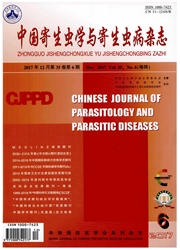

 中文摘要:
中文摘要:
目的利用哨鼠监测血吸虫病高风险区域的水体感染情况,并根据监测结果作出预警。方法在湖南、湖北、江西、安徽、江苏、云南和四川等7个省47个县(市、区)选择72个易感水域监测点,分别于2012年6~7月和9月投放1组小鼠,每组20只,分成2笼,固定悬浮于水面,每次测定2d,每天4h,现场测定后哨鼠带回实验室饲养35d后,在实验室解剖观察血吸虫感染情况。结果2012年6~7月和9月在7个省47个县(市、区)设立了72个监测点,共投放哨鼠3283只,回收并解剖哨鼠3062只,剖检率为93-3%;共检出6个阳性点,其中2个阳性点在2次监测中均发现阳性哨鼠;阳性点总出现率为8.3%(6/72),其中6~7月份和9月份的阳性点出现率分别为8.3%(6/72)和2.8%(2/72);发现阳性哨鼠33只,哨鼠总感染率为1.08%(33/3062),检获血吸虫成虫1085条,阳性鼠平均虫荷为32.9条/鼠;6个阳性点主要分布在湖南(4个)和江西(2个),其中2个阳性点所在的县分别出现本地感染的急性血吸虫病例或异地报告疑似当地感染的急性血吸虫病例,针对6个阳性点均发出了预警并作出了现场处置。结论2012年全年共发现6处高风险水域。监测区域的血吸虫病感染风险范围较2010年显著缩小,但部分区域的血吸虫病感染风险程度仍然较高。
 英文摘要:
英文摘要:
Objective To monitor water body infestation in schistosomiasis high-risk areas with sentinel mouse technique. Methods A total of 72 surveillance sites from 47 counties were selected in Hunan, Hubei, Jiangxi, Anhui, Jiangsu, Yunnan, and Sichuan. The water infectivity of Schistosoma japonicum was determined in the surveillance sites by using sentinel mice during June-July and September, 2012. Results Among the 3 283 sentinel mice which were placed in 72 sites, 3 062 (93.3%) were recovered and dissected. Infected sentinel mice were found in six sites accounting for8.3% (6/72) of the total surveillance sites, with an occurrence rate of sites with infected mice of 8.3% in June-July and 2.8% in September. 33 infected mice were discovered with a total infection rate of 1.08% (33/3 062). 1085 adult worms were collected, with a mean worm burden of 32.9 worms per mouse in infected sentinel mice. 4 positive sites were in Hunan and 2 were in Jiangxi. Local acute schistosomiasis or suspected local acute cases which detected elsewhere were reported in 2 positive sites. Some follow-up activities were conducted in the 6 positive sites. Conclusion Compared with those in 2010, the schistosomiasis risk areas are shrinking in 2012. However, some regions are still the schistosomiasis high-risk areas.
 同期刊论文项目
同期刊论文项目
 同项目期刊论文
同项目期刊论文
 Successful outcome of an integrated strategy for the reduction of schistosomiasis transmission in an
Successful outcome of an integrated strategy for the reduction of schistosomiasis transmission in an Isolation and Characterization of 15 New Microsatellite Markers in Oncomelania hupensis, the Snail I
Isolation and Characterization of 15 New Microsatellite Markers in Oncomelania hupensis, the Snail I Exploring the Potential Transmission Risk of Schistosomiasis Japonica in the Lower Reaches of the Ya
Exploring the Potential Transmission Risk of Schistosomiasis Japonica in the Lower Reaches of the Ya Potential schistosomiasis foci in China: A prospective study for schistosomiasis surveillance and re
Potential schistosomiasis foci in China: A prospective study for schistosomiasis surveillance and re Fine Scale Spatial-temporal Cluster Analysis for the Infection Risk of Schistosomiasis Japonica Usin
Fine Scale Spatial-temporal Cluster Analysis for the Infection Risk of Schistosomiasis Japonica Usin 期刊信息
期刊信息
